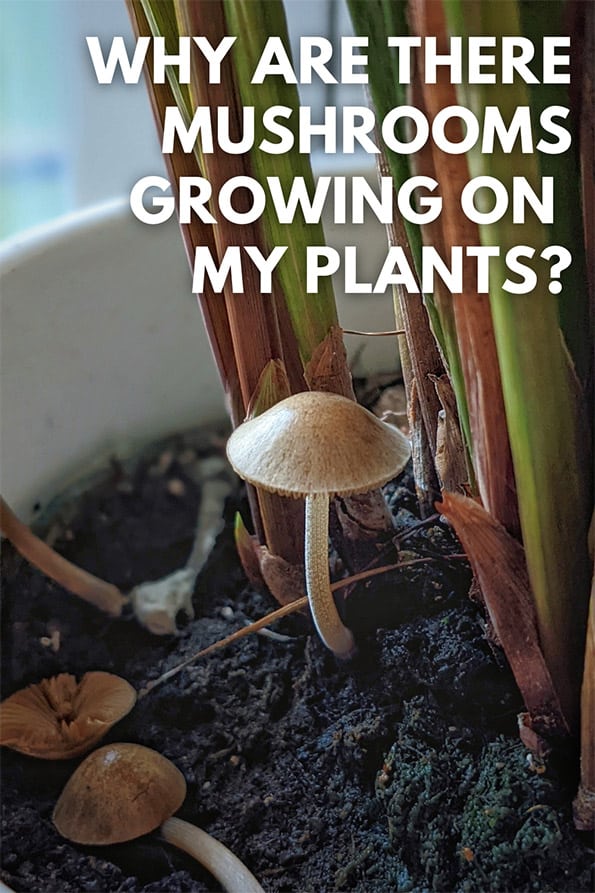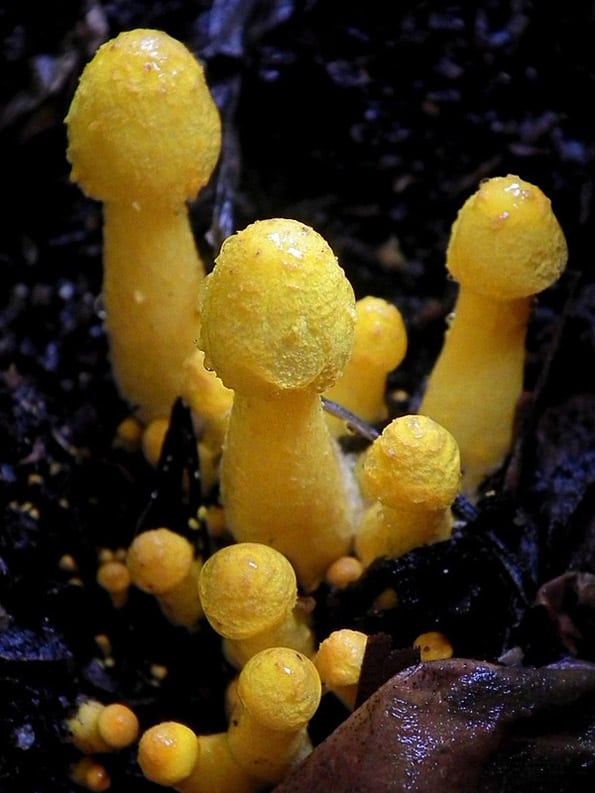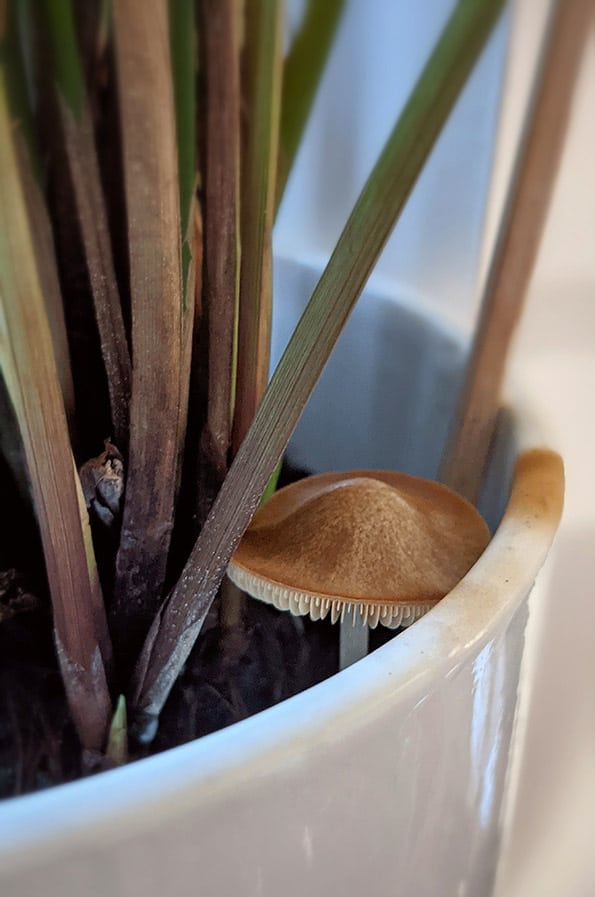The reasons they've appeared around your indoor plant is due to a mix of rich soil, moisture from watering or high humidity levels, and mushroom spores within the potting soil.
If you find mushrooms growing on your houseplant soil, then it might come as a shock. They can appear and grow fast, almost springing up overnight. They're not generally something to worry about though and I'll explain why below.
Mushroom growing in the potting soil of a potted plant. They feed off organic material and love humid conditions, but in most cases they're not a bad thing to see or something to worry about.
If you find a mushroom growing in a potted plant, it's almost certainly unexpected and might even get you gasping, "What the heck is that growing in my plant?". You can get brown, white or the odd yellow mushroom all showing up.
Are they Mushrooms or Toadstools?
In theory, either term could be correct. Although "Toadstools" are usually referred to fungi that are poisonous. Whereas "Mushrooms" are often considered to be edible fungi.
In almost all cases it's not anything too drastic. Of all the unusual quirks and issues houseplant owners face, mushrooms growing should be way down that list of worries.
Some cultures even consider mushrooms in with your houseplants to be good luck. So if you find one, it's thought to bring you good fortune.
Outdoors, mushroom fungi can commonly be found growing on tree stumps or compost piles, helping to break down the decaying material. The sight of mushrooms in fairy rings can also be exciting and spark the imagination of small children.
But if you're reading this article, you're obviously curious or want to better understand why they're indoors and growing side by side with your potted plants. So let's get to the explaining.

Hi, I'm Tom!
If you're like me and enjoy the challenge of growing houseplants and getting them to thrive, then Ourhouseplants can help. This website shares my knowledge and years of growing plants and provides (hopefully) helpful advice on properly caring for your indoor plant friends.
In order for them to grow in the potting mix around your plant's soil, several environmental conditions must be met.
In the previous section, I explained that moisture, fertile, moist soil, and spores are needed for mushrooms to grow. This means all you have to do is remove one of these things, and the chances of them appearing drastically reduces.
But realistically, these are not things you can stop or prevent.
Your plants need moisture to survive. Even if you're careful not to overwater the potting medium, sometimes just a little moisture is enough to get the mushrooms growing.
Your plant also needs fertile soil to grow, so restricting or not ever feeding your plants isn't an option either.
Finally, the spores can't be seen with the human eye. So how can you possibly prevent these microscopic spores from ending up in your potting mix?
Answer - You can't.
Yellow Mushrooms like leucocoprinus birnbaumii (lepiota lutea) are fairly common in potted plants. This is also why they're sometimes called by the common name of flowerpot parasol or plantpot dapperling. - Photo by James Niland
Earlier I explained that wild mushrooms springing up are the occasional, but normal, part of indoor gardening. Ultimately as they cause so few issues for you or your plant, they're a low concern problem and not something to spend too much time worrying about.
So in most cases your time is better spent just removing them (which I'll cover in the next section). However there are a few occasions when you might want to change things up to try and prevent them from growing.
There is no compelling reason I can give you that would make me tell you to pull them out right now. But equally if you're not a fan, there is no reason not to remove them.
Can you eat Mushrooms growing around your house plant?
Although mushrooms have lots of health benefits. I don't recommend you eat those found around your houseplants, simply because you don't know what you have growing. There is a slim chance they could be toxic or classed as poisonous mushrooms.
However, in a few situations, it's worth getting rid of them, and I'll list them below.
If you do want to get rid of them, the best way is to simply pull them out and throw them away.
Some people pull them out and leave them on the soil surface to slowly rot away and return the nutrients to the potting mix for your plant to eventually use.
Theoretically, this is fine to do. However, if the visible mushroom you're pulling out has reached maturity, the spores could be formed and ready to go. Disturbing them like this could release the spores. So all you'll be doing is creating a potential situation where more mushrooms could end up growing in the soil of your houseplants in a few weeks time.
Pot plants can provide favorable conditions and space for mushroom growth to occur. They are usually harmless, but they can create a mess with the tiny spores they release as you can see here.
Below are a few occasions when I'd suggest removing mushrooms from your potted plants.
Mushrooms grow when the right conditions of moisture, fertile potting mixes and spores exist on the soil surface. This can be at any time of the year, but Spring and Fall are most common as they like warm conditions.
They're not generally harmful so you don't have to remove them. Often, the mushrooms will grow in lower light areas around the base of your houseplant. You might not even spot them initially (if at all).
If you do spot them, in certain circumstances, it's probably worthwhile removing them, or in extreme cases trying to prevent them altogether.
They're not directly providing a significant benefit to your houseplants, but neither are they causing a serious problem. So you can continue to let them rent out a space in the pot if you want to (or if you just can't be bothered to remove them).
Your houseplants aren't in trouble or suffering if mushrooms appear around your houseplants and you're probably not doing anything wrong.
Hopefully, this fully answers why mushrooms are growing in your plants' soil and has helped put your mind at ease. Maybe you didn't like mushrooms at first, but... Now they're growing on you (awful pun, I know!). Let me know in the comments (or share a better joke!).


